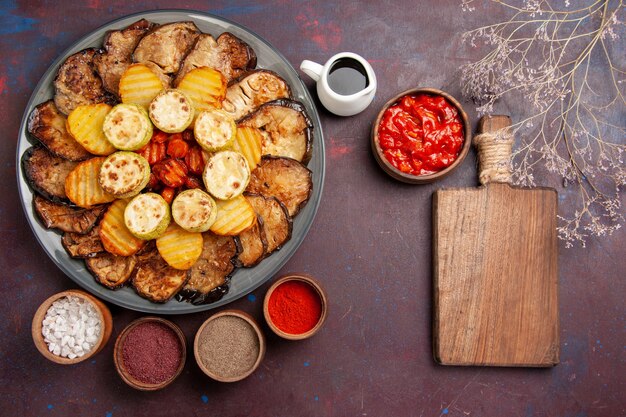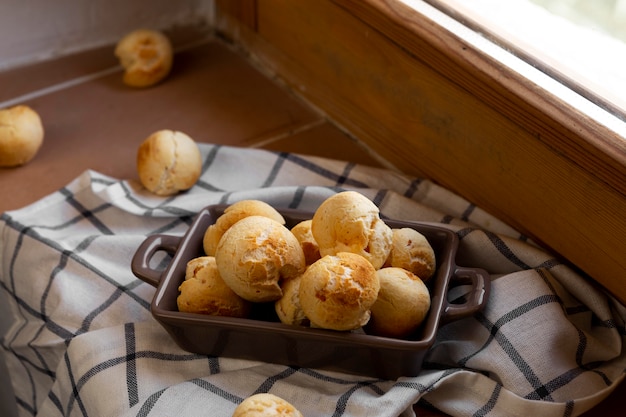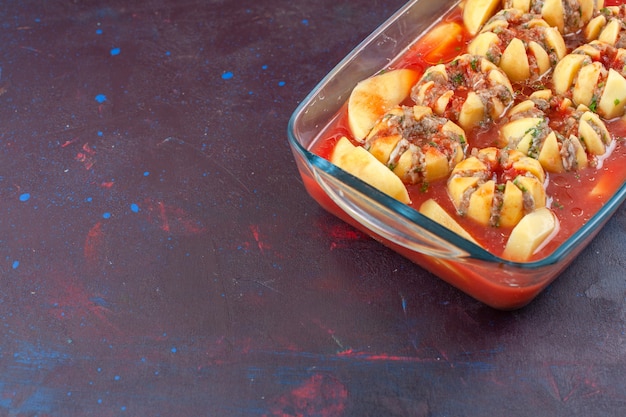Ah, roast potatoes. Those golden, crispy beauties that are the undisputed stars of the Sunday roast. They're the kind of side dish that can make or break a meal, turning a simple dinner into a culinary triumph. A truly excellent roast potato is a thing of beauty – a symphony of textures and flavours. That gloriously crisp exterior, yielding to a fluffy, slightly creamy interior, is a taste of pure comfort food heaven.
But let's be honest, getting that perfect roast potato isn't always a piece of cake. It's a bit of an art form, and it's taken me years of trial and error to master my technique. I've had my share of disasters, from soggy, sad potatoes to burnt, charcoal-like ones. But I've also had some absolute triumphs, potatoes so good they had guests fighting over the last one. So, consider this your ultimate guide to achieving roast potato perfection, a guide born from years of experience and a whole lot of experimentation.
(Part 1) The Potato Powerhouse

First things first, you need to choose the right potatoes. Not all potatoes are created equal when it comes to roasting. Some are perfectly suited for mashing, others for salads, but only a select few have the characteristics needed for that crispy perfection. I've tried a fair few over the years, and here are my top picks for getting that perfect roast potato:
The Classics:
- maris piper: These are my go-to potatoes for a classic roast. They hold their shape beautifully, meaning they won't fall apart during cooking, and they get that glorious crispy exterior that we all crave. Plus, they have a lovely floury texture that's just right for a roast.
- king edward: A bit more expensive than Maris Pipers, but worth it for their lovely fluffy interior and really nice flavour. They're known for their delicate flavour and soft texture, which is why they're a favourite for mash, but they also roast beautifully, especially if you want a more delicate flavour.
- Desiree: A good all-rounder, these are pretty forgiving and will always deliver a decent roast potato. They're not as crisp as Maris Pipers, but they are great for beginners and for those who want a potato that's a bit less starchy.
The Upgraders:
- Pink Fir Apple: These are a bit more waxy, which means they hold their shape even better than Maris Pipers, and they've got a lovely nutty flavour. They're perfect for those who prefer a firmer potato with a bit more bite.
- Charlotte: Another great option, these are known for their floury texture and delicious flavour. They're a bit more delicate than some other varieties, so you need to be careful not to overcook them.
The Ones to Avoid:
- New potatoes: These are best boiled or steamed. They tend to fall apart when roasted and don't get that crispy exterior you're looking for.
- waxy potatoes: These are great for salads and mash, but they won’t get that crispy exterior you're looking for. They also tend to be a bit bland when roasted.
A little tip: if you're in doubt, ask your local greengrocer. They'll be able to recommend the perfect potatoes for your needs, taking into account the size of your potatoes and what you're planning to cook them with.
(Part 2) The Pre-Roast Prep

Now, let's talk about prepping your potatoes. This is where you lay the foundation for that amazing roast.
1. The Scrub:
Give those potatoes a good scrub. No need to peel them; we want that skin for extra flavour and texture. It adds a lovely earthiness and a bit of crunch to the finished product. You can use a vegetable brush or a clean sponge to get rid of any dirt or debris. Make sure you get into all the crevices and nooks, especially if you’re using potatoes with a rough skin.
2. The Chop:
Cut your potatoes into even-sized chunks. This ensures they cook evenly and you get that perfect crispy exterior on all sides. I prefer them to be about the size of a large walnut. You can make them larger or smaller, but remember, the smaller the pieces, the faster they'll cook.
3. The Soak (Optional):
This is where things get interesting. Some folks swear by soaking their potatoes in cold water for an hour or so before roasting. This helps remove some of the starch, which can lead to a crispier potato. It's a bit of a controversial technique, some find it makes the potatoes a bit soggy. I personally don't do this, I find it makes the potatoes a bit soggy and it doesn't seem to make a huge difference in terms of crispiness. But it's up to you to experiment and find what works best for you.
(Part 3) The Roasting Ritual

Okay, you've prepped your potatoes. Now, it's time to get roasting!
1. The Preheat:
Get your oven nice and hot. I aim for around 200°C (400°F) fan-assisted. A hot oven is key for getting those potatoes crispy. A cooler oven will result in soggy potatoes, so don't be afraid to crank up the heat.
2. The Oil Bath:
Before you start roasting, toss your potatoes in a generous amount of oil. I like to use a good quality olive oil, but vegetable oil will also work just fine. This helps create that crisp exterior, The oil helps to create a barrier between the potato and the oven, preventing it from drying out too quickly.
3. The Seasoning Game:
Now comes the fun part: seasoning! This is where you can really get creative and add your own personal touch. I always start with salt and pepper, but feel free to get adventurous. Here are a few of my favourite flavour combinations:
- Classic: Salt, pepper, and rosemary. You can’t go wrong with this classic combination. It's simple, yet incredibly effective, enhancing the natural flavours of the potato.
- Mediterranean: Salt, pepper, oregano, and a squeeze of lemon juice. A bit of a brighter flavour profile for a change, perfect for a lighter roast.
- Spicy: Salt, pepper, paprika, and a pinch of cayenne pepper. A bit of a kick to your roast potatoes, ideal for those who like a little heat.
- Garlic Herb: Salt, pepper, garlic powder, thyme, and parsley. A delicious and aromatic flavour, perfect for a hearty roast.
Don't be afraid to experiment with different herbs and spices. You can even try adding a bit of garlic powder or onion powder for extra flavour. The key is to find a combination that you love.
4. The Roast:
Now, get your potatoes into the oven. Spread them out in a single layer on a baking tray, so they get crispy on all sides. You don't want them to be crowded together, or they'll steam instead of roast. You'll need to roast them for about 45 minutes to an hour, depending on the size of your potatoes. You want them to be golden brown and crispy on the outside, and fluffy on the inside.
5. The Shake-It-Up:
About halfway through the roasting time, give your potatoes a good shake or toss them around in the tray. This ensures that they cook evenly and get crispy on all sides. It also helps prevent sticking and ensures they don't get burnt on one side.
(Part 4) The Finishing Touches
You've got your potatoes roasting beautifully, now it's time to add a few finishing touches to elevate them to the next level.
1. The Roast with the Rest:
If you're roasting a joint of meat, you can often add the potatoes towards the end of the cooking time. This helps them absorb some of the delicious meat juices and gives them an extra layer of flavour. You can also add a little bit of the meat juices to the tray for extra flavour.
2. The Roasting Time:
When you think your potatoes are nearly done, have a little test. Carefully pierce a potato with a fork or skewer. If it goes in easily and the potato is golden brown and crispy, they’re ready to go! If they need a little more time, pop them back in the oven for another 5-10 minutes.
3. The Final Touch:
For a truly decadent touch, you can sprinkle a little bit of Parmesan cheese or herbs over your potatoes in the last 5 minutes of roasting. This adds an extra layer of flavour and crunch. You can also try adding a knob of butter, which will melt and create a lovely, glossy finish.
(Part 5) The Perfect Serving
Now, it's time to serve up your delicious roast potatoes! There's no wrong way to do this, but here are a few tips for making them shine:
1. The Warm Embrace:
Keep those potatoes warm while you finish preparing the rest of your meal. You can keep them in a warm oven or a covered dish. This will ensure they stay crispy and warm, ready to be enjoyed.
2. The Plate Presentation:
Arrange your potatoes on a platter or in individual bowls. If you're serving them with roast meat, you can place a few potatoes around the joint. You can also add a sprig of rosemary or a few other herbs for a touch of elegance.
3. The Condiments:
Roast potatoes are a blank canvas for flavour, and they pair beautifully with a variety of condiments. Here are a few of my favourites:
- Gravy: A classic pairing for a reason! The rich, savoury flavour of gravy is a perfect complement to the crispy potatoes.
- Mint sauce: A refreshing and tangy addition. The sharpness of the mint cuts through the richness of the potatoes, making for a delightful contrast.
- Apple sauce: A sweet and tangy contrast to the savoury potatoes. The sweetness of the apple sauce balances out the saltiness of the potatoes, making for a delicious combination.
- Yorkshire pudding: Who doesn't love a Yorkshire pudding with a roast? The fluffy, light texture of the Yorkshire pudding is a perfect contrast to the crispy potatoes.
Don't be afraid to get creative with your condiments. You can also try serving roast potatoes with a dollop of sour cream, a sprinkle of chopped chives, or a drizzle of honey.
(Part 6) The Leftover Love
Let’s be honest, you’re probably going to have some leftover roast potatoes. And that’s great! Roast potatoes are just as delicious cold as they are warm. Here are a few ideas for using up those leftovers:
1. The Cold potato salad:
Chop those leftover potatoes into bite-sized pieces and mix them with some mayonnaise, mustard, chopped onions, and herbs. A simple but satisfying salad! You can also add some chopped celery, pickles, or hard-boiled eggs for extra texture.
2. The Potato Hash:
Dice the potatoes and fry them with some chopped onions, peppers, and bacon. Season with salt, pepper, and a sprinkle of paprika. You can also add some other leftover vegetables, like mushrooms or spinach.
3. The potato soup:
Blend leftover potatoes with some broth, onions, and carrots for a comforting and delicious soup. You can also add a dollop of sour cream or some chopped chives for extra flavour.
Remember, leftover roast potatoes can be used in a variety of dishes, so don't throw them away!
(Part 7) The Science of Crispy Potatoes
You've got your crispy potatoes, but you might be wondering, what's the science behind their amazing texture? Here’s the lowdown:
1. The Starch Factor:
Potatoes are full of starch. When you roast them, the starch granules absorb water and expand. This expansion creates a fluffy interior. The amount of starch in a potato is one of the main factors that determines its texture.
2. The Maillard Reaction:
When you roast potatoes at high temperatures, a chemical reaction called the Maillard reaction occurs. This reaction creates the delicious brown colour and crispy texture of your potatoes. The Maillard reaction is a complex process that involves the interaction of sugars and amino acids in the potato, resulting in a wide range of flavour compounds.
3. The Moisture Factor:
The amount of moisture in your potatoes affects their texture. Too much moisture can lead to soggy potatoes, while too little moisture can lead to dry and crumbly potatoes. That's why getting the right potato variety and using the correct roasting technique is so important.
(Part 8) The Potato Troubleshooting
We've all been there. You've followed all the instructions, but your potatoes still aren’t quite right. Here are a few common problems and their solutions:
1. Soggy Potatoes:
This is usually caused by too much moisture. Ensure your potatoes are thoroughly dried before roasting, and don't overcrowd the baking tray. You can also try drying them with a clean tea towel or paper towels before roasting.
2. Burnt Potatoes:
This is usually caused by too high a temperature or not shaking the potatoes during roasting. Reduce the oven temperature or shake the potatoes more often. You can also try covering them with foil for the first part of the roasting time, which will help prevent them from burning.
3. Not Crispy Enough:
This could be due to using the wrong type of potatoes, not preheating the oven hot enough, or not roasting them long enough. Try using a different potato variety, ensure your oven is hot, and roast them for a bit longer. You can also try tossing them in a bit of cornstarch before roasting, which will help to absorb any excess moisture and create a crispier exterior.
(Part 9) The Potato Variations
Want to switch things up? Here are a few variations on the classic roast potato:
1. The sweet potato Roast:
Roast sweet potatoes in the same way as regular potatoes. They have a naturally sweet flavour that pairs well with a variety of spices, like cinnamon, ginger, and nutmeg. You can also try adding a pinch of chili powder for a spicy twist.
2. The Herb-Crusted Roast:
Coat your potatoes in a mixture of herbs like rosemary, thyme, and parsley. The herbs will add a fragrant and flavourful crust to your potatoes. You can also use a mixture of chopped herbs or a dry herb blend.
3. The Garlic-Roasted Potatoes:
Roast your potatoes with whole cloves of garlic. The garlic will infuse the potatoes with a delicious aroma and flavour. You can also try adding some chopped garlic to the oil before roasting.
4. The Parmesan-Roasted Potatoes:
Sprinkle grated Parmesan cheese over your potatoes during the last 10 minutes of roasting. This creates a cheesy and crispy crust. You can also try adding a sprinkle of other cheeses, like cheddar or mozzarella.
(Part 10) The Potato Inspiration
If you're looking for more inspiration, there are endless possibilities when it comes to roast potatoes. Check out some cookbooks, browse online recipes, or experiment with your own flavour combinations. And remember, the most important thing is to have fun with it!
FAQs
1. How do I know if my potatoes are cooked?
You can tell your potatoes are cooked when they are golden brown and crispy on the outside, and fluffy on the inside. You can also test them by piercing them with a fork or skewer. If it goes in easily, they're ready! If the inside of the potato is still firm, it needs more time in the oven.
2. What if my potatoes are sticking to the baking tray?
If your potatoes are sticking, you can try greasing the tray with a little more oil or lining it with parchment paper. You can also shake or toss the potatoes more often to prevent them from sticking. If you're using a dark-colored baking tray, try using a lighter-colored tray, which will help to prevent the potatoes from burning.
3. Can I roast potatoes in advance?
Yes, you can roast potatoes in advance. Simply roast them as usual, and then store them in an airtight container in the refrigerator for up to 3 days. Reheat them in a preheated oven until they are hot and crispy. You can also reheat them in a microwave, but they won't be as crispy.
4. How can I get my potatoes even crispier?
For extra crispy potatoes, you can try roasting them at a higher temperature or adding a bit of cornstarch to the oil before roasting. You can also try baking them in a preheated dutch oven, which will help trap the heat and make them even crispier.
5. Can I roast frozen potatoes?
Yes, you can roast frozen potatoes. Simply thaw them in the refrigerator overnight, then roast them as usual. You may need to roast them for a little longer than fresh potatoes. Frozen potatoes will likely be a bit softer than fresh potatoes, but they can still be delicious.
So, there you have it! My ultimate guide to crispy roast potatoes. Go forth and conquer! Remember, practice makes perfect, and with a little patience and experimentation, you'll be on your way to making the best roast potatoes you've ever tasted. Happy roasting!
Everyone is watching

How to Cook Frozen Lobster Tails Perfectly: A Step-by-Step Guide
RecipesLobster. Just the word conjures up images of lavish meals, special occasions, and a taste of luxury. But let's...

Pigs in a Blanket Cooking Time: How Long to Bake for Perfect Results
RecipesAh, pigs in a blanket. Just the name conjures up images of those delightful little parcels of crispy pastry en...

Pork Fillet Cooking Time: How Long to Cook It Perfectly
RecipesPork fillet, or tenderloin as it's sometimes called, is a real favourite in our house. It's so versatile, and...

The Ultimate Guide to Cooking Delicious Frankfurters
RecipesLet's face it, we all love a good frankfurter. It's a classic, simple, and always satisfying. But let's be rea...

Wolf Meat Recipes: A Guide to Cooking Wild Game
RecipesLet's be honest, you don't see wolf meat at your local butcher shop every day. It's a bit of a wild card, but ...
